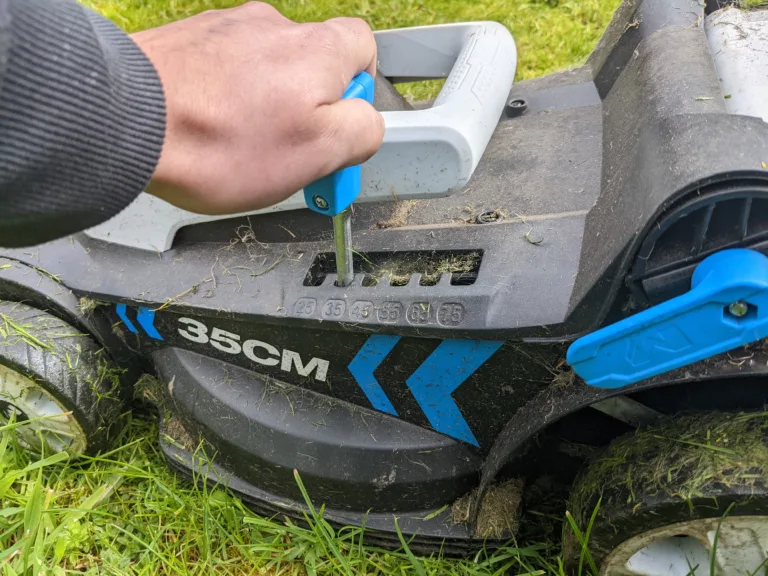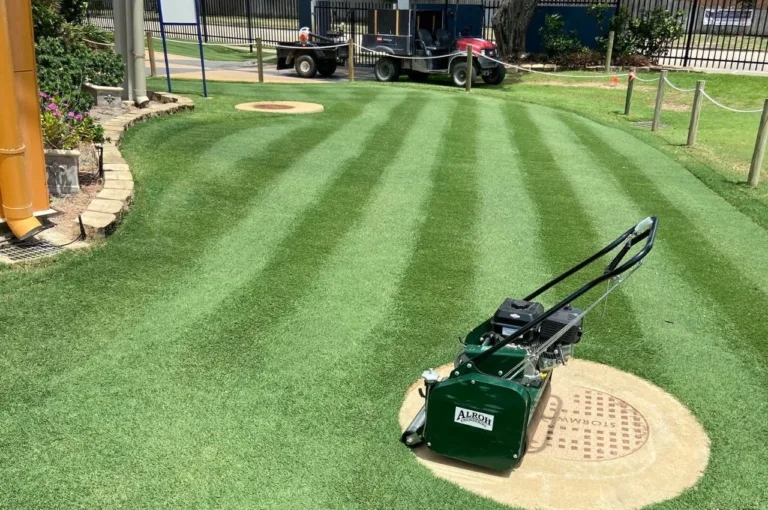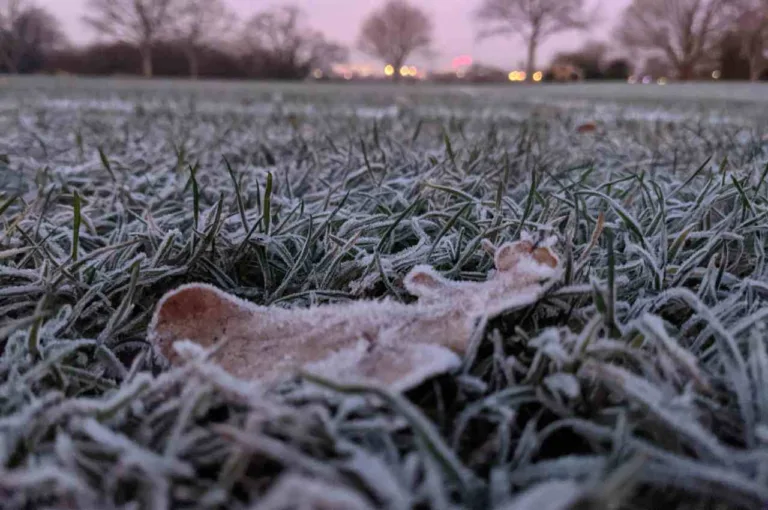You don’t technically need to mow your lawn in the winter because grass generally doesn’t grow when temperatures fall below 5 or 6 degrees celsius – so feel free to put your feet up for a few months.
There are a few occasions when you might need to mow your lawn, however, and it’s important to know how to do it properly in the colder season.
In this guide, I’ve shared our top advice on how to mow your lawn in winter.
✅ Key Takeaways:
Mowing your lawn isn’t usually necessary in winter because air temperatures are too low for grass to grow.
If you need to mow grass in winter, wait for a sunny day and mow later in the day, when the ground is less likely to be wet with frost or frozen solid.
As a general rule, keep your lawn at a maximum height of 4-6cm in winter, and only mow when you absolutely need to.
Table of Contents
❓⛄️ Should You Mow Your Lawn In The Winter?
You shouldn’t generally mow your lawn in winter because the weather conditions aren’t optimal for dragging a heavy mower around your garden.
For a start, when temperatures drop below 5-6 degrees, grass stops growing, so there’s no need to mow your lawn during spells of cold weather.
Plus, winter often brings with it damp, freezing conditions, and mowing a frosty lawn isn’t good for your mower or your grass health – and it could pose a safety risk if you use an electric lawn mower.
However, you can still technically mow your grass in the winter months, and there are a few reasons why you might want to.
For instance, in some winter months, the weather is still warm enough for grass to grow. This often happens in the UK: we’ll see temperatures of around 10 degrees right up until late December. If your grass is still growing, you’ll want to cut it to avoid having an overgrown garden all winter.
You might also have neglected your lawn mowing duties until the winter, or you might have moved into a new house with a lawn that badly needs cutting, prompting to get your mower out to fix the problem regardless of the time of the year.
So, while winter lawn mowing doesn’t need to be a part of the average person’s routine, there may be occasions when you will want to, or need to, mow your grass in the colder season – and that’s okay.
- Brand: Bosch
Price: ££
Power source: Electric corded
Cutting width: 34cm
Cut height range: 20-70mm
Weight: 11.09 kilograms
Grass box capacity: 40 litres
Dimensions (DxWxH): 61.6 x 37.8 x 40.2cm
Power: 1300 W
📝 How To Mow Your In Winter: 8 Top Tips
Read on for our top winter lawn mowing tips.
📆 Mow As Infrequently As Possible
So, you’ve decided that you need to cut down the long grass in your garden in the winter. It’s fine to do once or twice while temperatures are still just warm enough for grass to grow, but you should avoid mowing too frequently.
Ideally, you should aim to cut your lawn once, or twice at the most, during the cold season.
Mowing your lawn too frequently will put stress on your grass because you’re cutting it back faster than it’s growing, leading to bare patches and an increased likelihood of moss and weed growth.
Rather than mowing your grass because you feel you need to, observe your lawn and only mow when the grass blades reach around 4-6cm tall. If they don’t get this long, try to save your mowing duties until the following spring!
📏 Use A High Mowing Height
I recommend the one-third rule when mowing your lawn in any season. This rule says that you should never remove more than one third of the original grass blade height, which helps your grass to sustain healthy growth through photosynthesis.
This is especially important in the winter, when the sun’s rays are weaker and grass has a reduced opportunity to photosynthesize. If you cut your grass too short, you might cut off so much of the leaf that the grass leaves can’t harvest energy to stay alive.
Set your mower’s cutting height to no lower than 4cm so the grass blades in your garden can store enough energy to see through the winter months.

🔁 Mow In Different Patterns
Mowing a lawn in winter causes an increased likelihood of ruts and skid marks on your garden as a result of the mower wheels sinking into the moist, water-saturated soil.
If you have to mow your lawn more than once in the colder season, you can reduce the likelihood of wheel marks and soil damage by mowing in different patterns each time.
Start by mowing vertical laps, then switch to horizontal laps, then diagonal laps. This variation should prevent you from running over the same tracks every time you mow, so you shouldn’t leave visible brown marks in your lawn.
☀️ Wait For A Sunny Day
There aren’t many clear, dry days in the winter, but try to wait for one to come around before you schedule a mowing session.
There are numerous reasons why you shouldn’t mow wet grass, including:
Pushing your mower over damp soil will leave wheel ruts in the earth and mess up your lawn’s appearance.
Wet grass blades will clump together and potentially clog your mower, putting extra strain on the motor.
Lawn mowers struggle to suck wet clippings into their grass bags or boxes, so you’ll have a bigger mess on your lawn to rake up after mowing.
Mowing wet or frozen grass could even pose an electrocution risk if you use an electric lawn mower.
If you absolutely have to mow wet or froezn grass, follow our guide on how to cut grass that’s wet.

🌓 Mow Later In The Day
I don’t recommend mowing your lawn in the early morning on winter days because you’re most likely to have wet or frosty grass in the morning, after a cold night of sub-zero temperatures.
Wait until at least early afternoon, when the sun’s rays have had the chance to dry and defrost your lawn, before you get your mower out. This will reduce issues associated with mowing wet grass, helping you to sustain a healthy lawn.
⏰ Wait for The Frost To Pass
There’s absolutely no reason to mow your lawn when it’s frosty, since frozen grass won’t grow at all.
Even if you notice that your grass height is taller than you’d like, wait until the frost has passed before you schedule in a mowing session. Your grass won’t grow any taller within this time.
Cutting grass that’s frosty is bad for your lawn health, and so is walking on frosty grass. You’ll damage the cells inside the grass, potentially killing the whole leaf and causing it to turn brown. For the sake of a healthy lawn, avoid walking on your grass when the temperature drops below zero.

✂️ Remove All Your Clippings
In the winter, your lawn needs to be exposed to as much sunlight as possible. Rake the grass clippings or blow them off your lawn with a leaf blower after you’ve finished mowing to give the grass plants the greatest opportunity to photosynthesize.
Leaving clippings on your lawn in winter also increases the likelihood of fungal diseases like fusarium patch, so I strongly recommend taking the extra time to clean up after mowing to avoid grass health complications that could become a year-round problem.
🌱 Consider Using A Winter Grass Feed
You might want to counteract the potentially damaging effects of mowing your lawn in winter by using a winter grass feed that can strengthen the roots and protect the grass blades throughout the cold months.
There are a few different fertilizers you can use to keep your lawn looking its best over winter. Do your research and find one that’s a suitable price point and adequate for your lawn’s surface area.
☎️ Final Word
If you desperately need to cut your lawn in winter, you can do so – and you don’t have to compromise your grass health in the process.
Follow the winter lawn care advice in this guide to safely and efficiently cut your lawn in the colder season. If you’re concerned or uncertain, I recommend waiting it out. It’s unlikely that your grass will grow much taller until early spring, when it’s safe to start putting practical effort into your garden one more.



